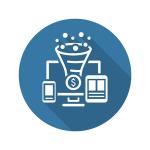The New Speed of Sales: 4 Resources and Tools Your Team Needs To Thrive



The past 15 years have brought about a lot of change in the technology world. Flashback to the year 2000: a tablet was a piece of stone and birds were the only things that tweeted. It’s not just technology that has changed dramatically—the state of sales and how businesses engage with customers has too.
The past 15 years have brought about a lot of change in the technology world.
Flashback to the year 2000: a tablet was a piece of stone and birds were the only things that tweeted. It’s not just technology that has changed dramatically—the state of sales and how businesses engage with customers has too.
The rise of mobile and social technologies has made customers more empowered and knowledgeable than ever before. Gone are the days when the salesperson was the go-to source for product knowledge and buying decisions were made solely in-store or after speaking with a sales rep. Today, the customer researches a product or service long and hard before even setting foot in a business or picking up the phone.
In fact, according to the corporate advisory firm CEB, customers are already 57 per cent through the buying cycle before engaging with a salesperson. When customers finally do make contact and engage seriously with a brand, the selling cycle is competitive and compressed, and salespeople need to move quickly to close the deal.
It’s clear that the invisible hand of technology is supercharging the sales cycle like never before and while potentially seen as a threat—businesses that equip their sales teams with the best tools and resources can be at a great advantage.
When customers are primed and ready to make a deal, salespeople need to be ready to move. To make this happen, it’s important for sales teams to maximize technology, particularly analytics and mobile, and leverage the available expertise across their entire organization to help close the deal.
Here’s how a sales team can stay one step ahead and help convert prospective customers into satisfied clients:
Use business analytics
A business no longer needs a full-time data scientist to break down data and conduct predictive analysis. Analytics for business users make it easy for sales teams to access and explore data such as revenue by quarter, year-over-year sales rep productivity and opportunity conversion rates to surface undiscovered trends and pinpoint areas to focus on to maximize future growth.
Predictive analytics represents the next phase of analytics innovation by taking a look at historical and current data to make forward-looking predictions, allowing salespeople to exploit patterns found in data to identify opportunities and isolate risks. This will not only help recognize the changing behaviour of customers but also provide salespeople with real-time data around customer preferences, lifestyle, and purchase habits, and then allow them to act on that data to increase conversions and create a 360-degree view of the customer.
Go mobile
If you haven’t made a mobile sales strategy in your business then today is the day to start. The universe of smartphones, tablets and apps in the consumer world has created equal demand for always connected mobile access in the business world. Today’s top sales organizations are significantly more likely to use mobile sales apps for everything from lead management to sales forecasting, letting them close deals from anywhere.
A great way for a business to kick start its own mobile sales strategy is with enterprise productivity apps and mobile CRM. Enterprise productivity apps help sales reps become more dynamic on the go while mobile CRM improves sales reps effectiveness by providing real-time access to analytics, sales intelligence and account planning tools wherever they are.
Break down silos
Organizations that are rising to the top are those that have mastered a holistic customer approach— they know that today’s sophisticated buyer has an equally complex and unique relationship with a business, extending to every sales, marketing, and service touch point. Your sales team needs to understand this and see sales as the responsibility of the whole company, adopting a true team-selling approach.
Master technology and innovation
The best sales teams meet the needs of today’s customers by working smarter with technology solutions. They’re significantly more likely to have already replaced all or most of their sales apps with cloud-based solutions and have supercharged their processes so they can spend time wisely—selling and making customers successful. They see growth opportunities around connected devices and wearables, and they consider how cutting-edge advancements can help reps stay connected and informed.
What will happen in the next 15 years, no one knows, but by using analytics, going mobile, breaking down silos and mastering technology and innovation, sales teams will not only be able to exist in this new state of sales, they will excel and be able to adapt to quickly-changing customer behaviours.
Learn how the future of intelligent selling is powered by data with Salesforce’s free eBook:























